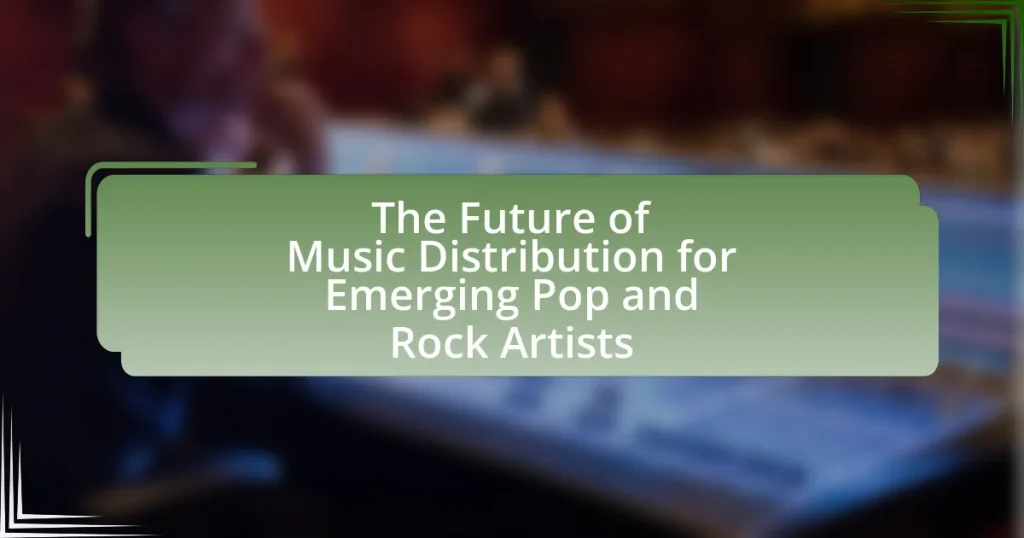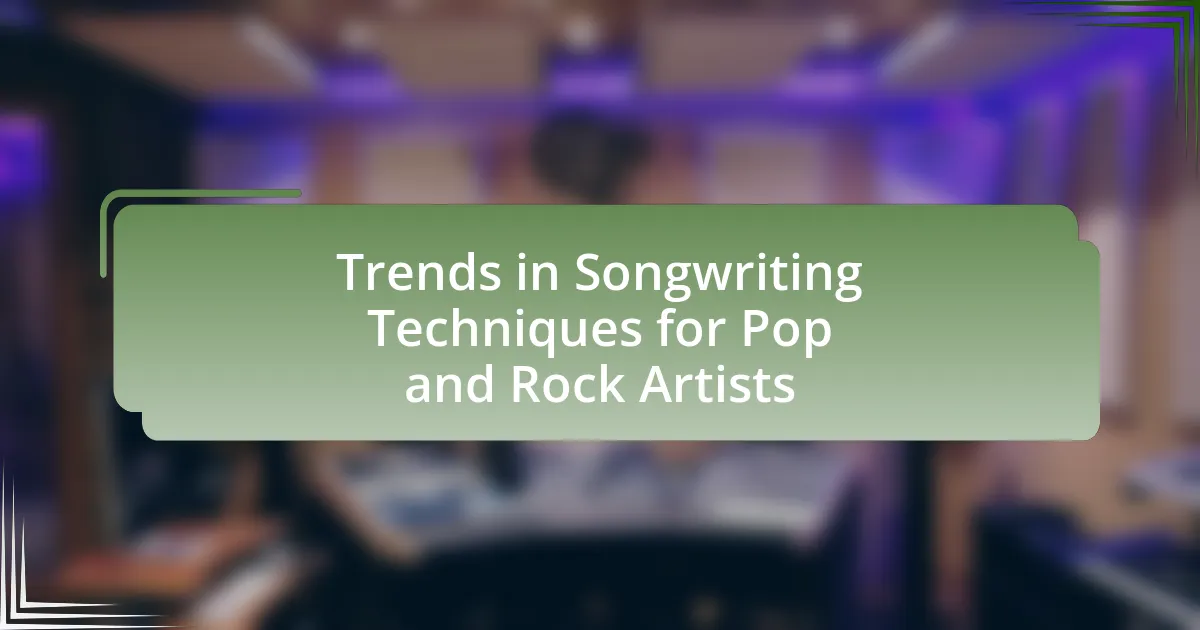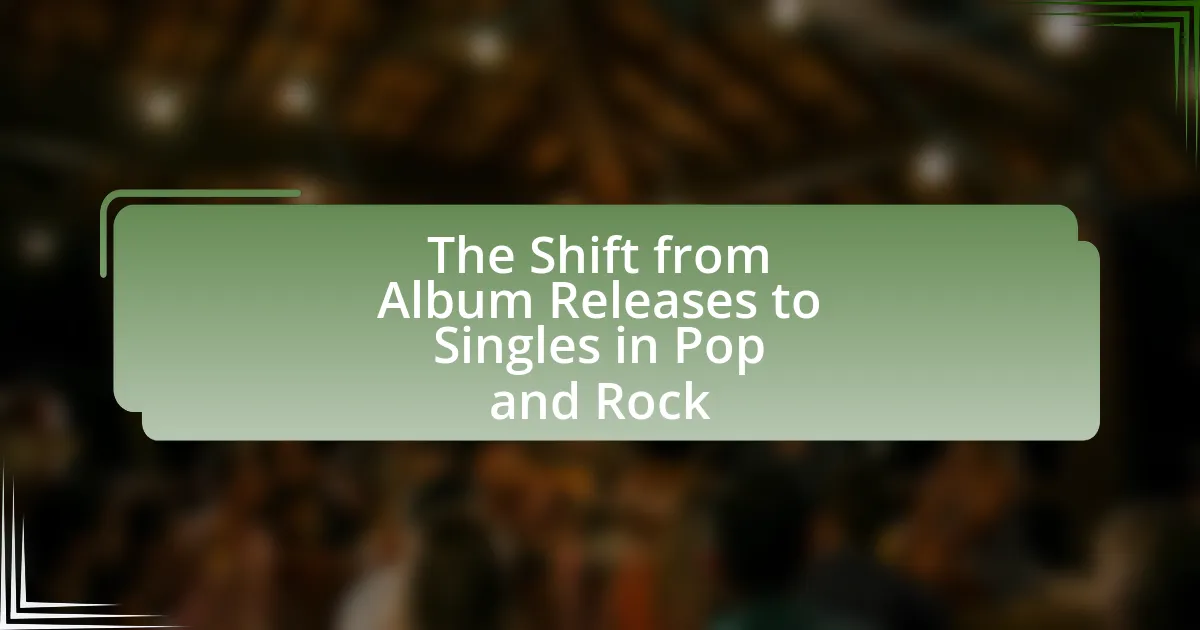The article focuses on the future of music distribution for emerging pop and rock artists, emphasizing the shift towards digital platforms and direct-to-fan models. It highlights the dominance of streaming services, which accounted for 83% of U.S. music revenue in 2022, and the growing importance of social media for music promotion. Key topics include the evolution of distribution strategies, technological advancements such as blockchain and AI, and the challenges faced by independent artists in a competitive market. The article also discusses effective distribution strategies, the role of collaborations, and best practices for engaging with fans online, providing practical tips for artists to enhance their visibility and revenue in the digital landscape.

What is the Future of Music Distribution for Emerging Pop and Rock Artists?
The future of music distribution for emerging pop and rock artists will increasingly rely on digital platforms and direct-to-fan models. As streaming services dominate the market, artists can leverage platforms like Spotify, Apple Music, and Bandcamp to reach global audiences without traditional label constraints. According to the Recording Industry Association of America (RIAA), streaming accounted for 83% of the U.S. music industry’s revenue in 2022, highlighting the shift towards digital consumption. Additionally, social media platforms such as TikTok and Instagram are becoming vital for music promotion, allowing artists to engage directly with fans and create viral moments that can lead to increased streams and sales. This trend indicates that emerging artists will need to adopt innovative marketing strategies and utilize data analytics to optimize their distribution efforts effectively.
How is music distribution evolving in the digital age?
Music distribution is evolving in the digital age through the rise of streaming platforms, direct-to-fan sales, and social media integration. Streaming services like Spotify and Apple Music dominate the market, accounting for over 80% of music revenue in the U.S. as of 2022, which has shifted the focus from physical sales to digital access. Additionally, artists now utilize platforms such as Bandcamp and SoundCloud to sell music directly to fans, bypassing traditional record labels. Social media platforms, including TikTok and Instagram, enable artists to promote their music and engage with audiences, further transforming how music reaches listeners. This evolution reflects a significant change in the music industry, emphasizing accessibility and artist autonomy.
What technological advancements are shaping music distribution?
Technological advancements shaping music distribution include streaming platforms, blockchain technology, and artificial intelligence. Streaming platforms like Spotify and Apple Music have revolutionized how music is consumed, allowing artists to reach global audiences instantly. Blockchain technology enhances transparency and security in royalty payments, ensuring artists receive fair compensation for their work. Artificial intelligence is being utilized for personalized music recommendations and data analytics, helping artists understand their audience better and optimize their marketing strategies. These advancements collectively transform the landscape of music distribution, making it more accessible and efficient for emerging pop and rock artists.
How do streaming platforms influence distribution strategies?
Streaming platforms significantly influence distribution strategies by prioritizing digital access and data-driven decision-making. These platforms, such as Spotify and Apple Music, have shifted the focus from physical sales to streaming metrics, compelling artists and labels to adapt their release schedules and marketing efforts accordingly. For instance, the prevalence of playlist placements on these platforms has become a critical factor in an artist’s visibility and success, leading to strategies that emphasize single releases over traditional album launches. Additionally, data analytics provided by streaming services allow artists to understand listener demographics and preferences, enabling targeted marketing and tailored content. This shift has been evidenced by the rise of independent artists who leverage streaming data to optimize their distribution and reach wider audiences without relying on traditional record label support.
Why is music distribution crucial for emerging artists?
Music distribution is crucial for emerging artists because it enables them to reach a wider audience and monetize their work effectively. By utilizing digital distribution platforms, artists can place their music on major streaming services like Spotify and Apple Music, which collectively account for over 80% of music consumption in the U.S. This access not only increases visibility but also allows for data analytics that can inform marketing strategies and audience engagement. Furthermore, effective distribution can lead to opportunities for playlist placements, which are essential for gaining traction in a competitive market.
What challenges do emerging artists face in music distribution?
Emerging artists face significant challenges in music distribution, primarily due to limited access to established distribution networks. These artists often struggle with visibility in a saturated market, where major platforms prioritize well-known acts, making it difficult for new talent to gain traction. Additionally, financial constraints hinder their ability to invest in marketing and promotional efforts, which are crucial for reaching wider audiences. According to a 2021 report by the International Federation of the Phonographic Industry, independent artists accounted for only 12% of global recorded music revenue, highlighting the economic barriers they encounter. Furthermore, the complexity of digital distribution channels can overwhelm emerging artists, as they must navigate various platforms, each with different requirements and algorithms that affect their music’s reach.
How can effective distribution impact an artist’s career?
Effective distribution significantly enhances an artist’s career by increasing their visibility and accessibility to a broader audience. When artists utilize effective distribution channels, such as streaming platforms and social media, they can reach millions of potential listeners, which can lead to higher streaming numbers and increased fan engagement. For instance, according to a report by the International Federation of the Phonographic Industry (IFPI), 70% of music consumption now occurs through streaming services, highlighting the importance of effective distribution in reaching audiences. Furthermore, artists with strong distribution strategies often see improved sales and concert attendance, as their music becomes more readily available to fans.
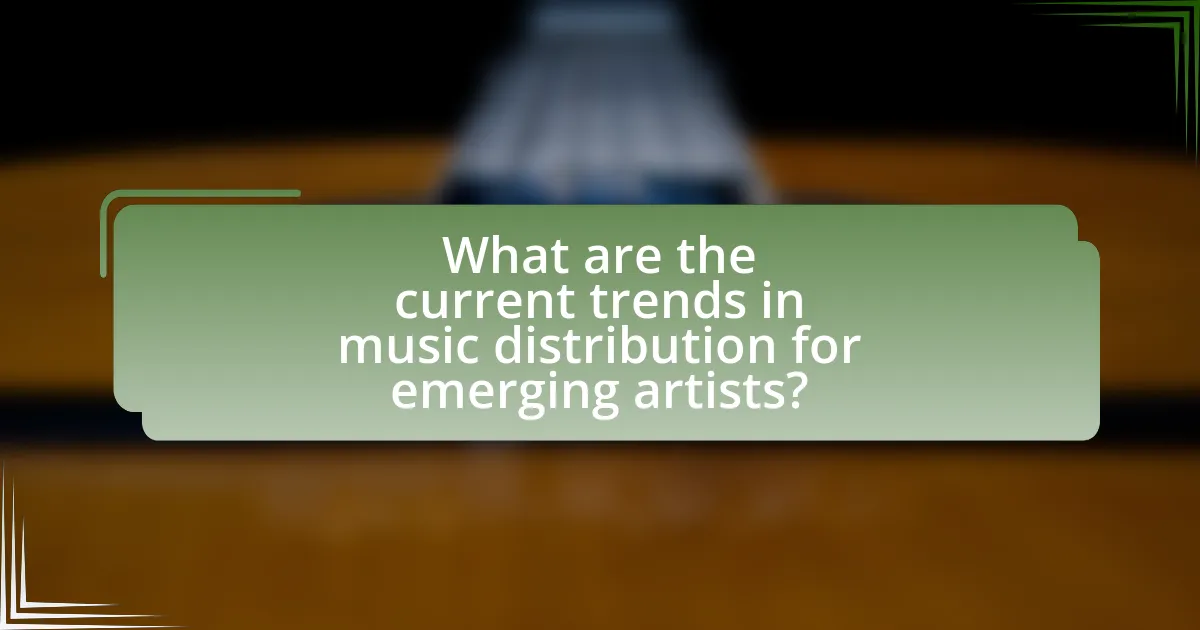
What are the current trends in music distribution for emerging artists?
Current trends in music distribution for emerging artists include the rise of digital platforms, direct-to-fan sales, and the use of social media for promotion. Digital platforms like Spotify, Apple Music, and Bandcamp have become essential for artists to reach global audiences, with over 400 million users on Spotify alone as of 2023. Direct-to-fan sales through platforms such as Patreon and Bandcamp allow artists to retain a larger share of revenue, fostering a closer connection with their audience. Additionally, social media platforms like TikTok and Instagram are increasingly used for music promotion, with viral trends significantly impacting song popularity and streaming numbers. These trends reflect a shift towards more accessible and artist-driven distribution methods in the music industry.
How are social media platforms changing music distribution?
Social media platforms are revolutionizing music distribution by enabling artists to directly share their music with audiences, bypassing traditional gatekeepers like record labels. This shift allows emerging pop and rock artists to reach global audiences instantly, as platforms like Instagram, TikTok, and YouTube facilitate viral marketing and fan engagement. For instance, TikTok has become a significant driver of music discovery, with songs often gaining popularity through user-generated content, leading to chart success without conventional promotion. According to a report by the Recording Industry Association of America, streaming revenue, largely driven by social media exposure, accounted for 83% of the U.S. music industry’s revenue in 2022, highlighting the critical role of these platforms in modern music distribution.
What role do influencers play in promoting new music?
Influencers play a crucial role in promoting new music by leveraging their large followings to amplify artists’ reach and engagement. They create buzz around new releases through social media platforms, often sharing snippets, reviews, or personal endorsements that can significantly increase an artist’s visibility. For instance, a study by the Digital Marketing Institute found that 49% of consumers depend on influencer recommendations when making purchase decisions, highlighting the effectiveness of influencers in shaping public perception and driving music consumption. This dynamic allows emerging pop and rock artists to connect with potential fans who may not have discovered their music through traditional channels.
How can artists leverage social media for distribution?
Artists can leverage social media for distribution by utilizing platforms like Instagram, TikTok, and YouTube to share their music directly with audiences. These platforms allow artists to reach millions of potential listeners without the need for traditional distribution channels. For instance, TikTok has become a significant driver of music discovery, with songs going viral and leading to increased streams on platforms like Spotify. According to a report by the Recording Industry Association of America, music streaming revenue in the U.S. reached $12.3 billion in 2021, highlighting the importance of digital platforms in music distribution. By engaging with fans through live streams, behind-the-scenes content, and interactive posts, artists can build a loyal following and promote their music effectively.
What are the benefits of independent distribution for emerging artists?
Independent distribution offers emerging artists greater control over their music, allowing them to retain a larger share of their profits. This model enables artists to set their own pricing, choose their release schedules, and maintain ownership of their intellectual property. Additionally, independent distribution platforms often provide access to a wider range of digital streaming services and social media channels, enhancing visibility and audience reach. According to a 2021 report by the International Federation of the Phonographic Industry, independent artists who utilize these platforms can earn up to 70% of their revenue compared to traditional label contracts, which typically offer only 10-20%. This financial advantage, combined with the ability to engage directly with fans, positions independent distribution as a vital strategy for emerging artists in the evolving music landscape.
How does independent distribution differ from traditional methods?
Independent distribution allows artists to retain full control over their music and revenue, contrasting with traditional methods where record labels typically manage distribution and take a significant portion of profits. Independent distribution platforms, such as DistroKid and TuneCore, enable artists to upload their music directly to streaming services, bypassing intermediaries. This model has gained traction, as evidenced by the rise of independent artists on platforms like Spotify, where over 30% of tracks are released by independent labels or self-released artists. In contrast, traditional distribution often involves lengthy contracts and limited creative freedom, which can hinder an artist’s ability to innovate and connect with their audience.
What platforms are best for independent music distribution?
The best platforms for independent music distribution include DistroKid, TuneCore, and CD Baby. DistroKid offers unlimited uploads for a yearly fee and distributes music to over 150 platforms, including Spotify and Apple Music. TuneCore charges per release but provides detailed sales reports and access to a wide range of digital stores. CD Baby allows artists to sell physical copies and offers a one-time fee for distribution to major streaming services. These platforms are widely recognized for their user-friendly interfaces and extensive reach, making them ideal for independent artists seeking to maximize their audience.
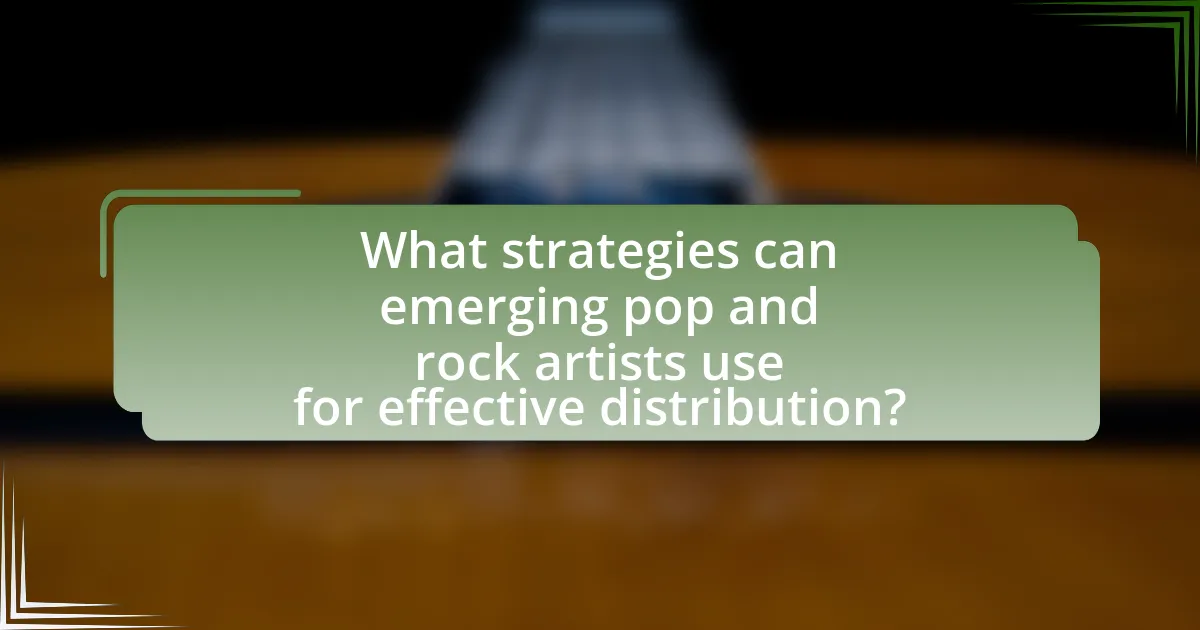
What strategies can emerging pop and rock artists use for effective distribution?
Emerging pop and rock artists can utilize digital distribution platforms, social media marketing, and direct-to-fan sales strategies for effective distribution. Digital distribution platforms like DistroKid and TuneCore allow artists to release their music on major streaming services, increasing accessibility and reach. Social media marketing enables artists to engage with their audience, promote new releases, and build a fanbase, as evidenced by the fact that 70% of music discovery occurs on platforms like Instagram and TikTok. Direct-to-fan sales strategies, such as offering exclusive content or merchandise through platforms like Bandcamp, foster a deeper connection with fans and can lead to increased revenue. These strategies collectively enhance visibility and facilitate a more sustainable career in the music industry.
How can artists build a strong online presence for distribution?
Artists can build a strong online presence for distribution by utilizing social media platforms, creating engaging content, and optimizing their music for streaming services. Social media platforms like Instagram, TikTok, and Twitter allow artists to connect directly with fans, share updates, and promote their music effectively. Engaging content, such as behind-the-scenes videos, live performances, and interactive posts, helps to foster a loyal fanbase. Additionally, optimizing music for streaming services involves ensuring high-quality audio, proper metadata, and strategic release schedules, which can enhance visibility and increase chances of playlist placements. According to a report by the International Federation of the Phonographic Industry, 70% of music consumption now occurs through streaming, highlighting the importance of a strong online presence for distribution.
What are the best practices for engaging with fans online?
The best practices for engaging with fans online include consistent communication, personalized interactions, and creating valuable content. Consistent communication fosters a sense of community and keeps fans informed about updates, releases, and events. Personalized interactions, such as responding to comments and messages, make fans feel valued and strengthen their connection to the artist. Creating valuable content, including behind-the-scenes footage, exclusive previews, and interactive posts, enhances fan engagement and encourages sharing. Research indicates that artists who actively engage with their audience see a 30% increase in fan loyalty and retention, demonstrating the effectiveness of these practices.
How can artists utilize data analytics to improve distribution?
Artists can utilize data analytics to improve distribution by analyzing listener demographics, streaming patterns, and engagement metrics. By leveraging platforms like Spotify for Artists and Apple Music Analytics, musicians can identify which songs resonate with specific audiences, allowing them to tailor their marketing strategies and distribution channels accordingly. For instance, data showing higher engagement in certain regions can guide artists to focus promotional efforts in those areas, optimizing their reach. Additionally, understanding peak listening times can inform release schedules, maximizing initial impact. This data-driven approach has been validated by studies indicating that artists who actively engage with analytics see a significant increase in audience growth and revenue.
What role does collaboration play in music distribution?
Collaboration plays a crucial role in music distribution by enhancing reach and engagement for artists. When musicians collaborate, they can leverage each other’s fan bases, increasing exposure and potential sales. For instance, a study by Nielsen Music found that collaborations can lead to a 30% increase in streaming numbers compared to solo releases. This synergy not only broadens the audience but also fosters creative innovation, making the music more appealing to diverse listeners. Additionally, partnerships with distribution platforms and other artists can streamline the distribution process, ensuring that music reaches a wider audience more efficiently.
How can partnerships enhance distribution efforts?
Partnerships can enhance distribution efforts by leveraging combined resources and networks to reach broader audiences. For instance, when emerging pop and rock artists collaborate with established labels or distribution platforms, they gain access to pre-existing distribution channels, marketing expertise, and promotional strategies that would otherwise be difficult to achieve independently. This collaborative approach can lead to increased visibility and sales, as evidenced by the success of artists who have partnered with major streaming services, which often report higher engagement metrics for collaborative releases.
What types of collaborations are most beneficial for emerging artists?
Collaborations that are most beneficial for emerging artists include partnerships with established artists, producers, and brands. Collaborating with established artists can provide exposure to larger audiences, as their fan base may be introduced to the emerging artist’s work. Working with experienced producers can enhance the quality of the music, leading to better production values and potentially more radio play. Additionally, brand collaborations can offer financial support and marketing resources, which are crucial for visibility in a competitive industry. According to a study by the Berklee College of Music, collaborations can significantly increase streaming numbers and social media engagement for emerging artists, validating the effectiveness of these partnerships.
What are the common pitfalls in music distribution for emerging artists?
Common pitfalls in music distribution for emerging artists include lack of understanding of distribution platforms, inadequate marketing strategies, and failure to optimize for streaming services. Emerging artists often choose distribution services without fully researching their terms, which can lead to unfavorable revenue splits or hidden fees. Additionally, many artists neglect to create a comprehensive marketing plan, resulting in limited visibility and engagement with their target audience. Furthermore, not optimizing their music for streaming algorithms can hinder discoverability, as platforms prioritize tracks that are well-promoted and frequently streamed. These pitfalls can significantly impact an artist’s ability to reach their audience and generate revenue.
How can artists avoid common distribution mistakes?
Artists can avoid common distribution mistakes by thoroughly researching and selecting the right distribution platforms that align with their target audience and genre. By understanding the specific features, fees, and reach of various platforms, artists can make informed decisions that enhance their visibility and revenue potential. For instance, platforms like DistroKid and TuneCore offer different pricing structures and services, which can significantly impact an artist’s earnings and exposure. Additionally, artists should ensure they have a clear marketing strategy in place to promote their releases effectively, as neglecting this aspect can lead to underwhelming sales and engagement.
What should artists consider when choosing a distribution partner?
Artists should consider the distribution partner’s reach and services when making their choice. A distribution partner with a wide network can ensure that music reaches a larger audience across various platforms, which is crucial for emerging pop and rock artists. Additionally, artists should evaluate the partner’s royalty structure, as favorable terms can significantly impact their earnings. For instance, some distributors offer higher percentages of royalties compared to others, which can be a deciding factor. Furthermore, the availability of marketing support and promotional tools is essential, as these resources can enhance visibility and engagement with potential fans. Lastly, artists should assess the partner’s reputation and reliability, as a trustworthy distributor can provide peace of mind and a smoother distribution process.
What practical tips can emerging artists follow for successful music distribution?
Emerging artists can achieve successful music distribution by utilizing digital distribution platforms effectively. These platforms, such as DistroKid, TuneCore, and CD Baby, allow artists to distribute their music to major streaming services like Spotify, Apple Music, and Amazon Music, ensuring broad accessibility. Additionally, artists should focus on building a strong online presence through social media and engaging with their audience to create a loyal fan base. According to a 2021 report by the International Federation of the Phonographic Industry, over 70% of music consumption now occurs through streaming, highlighting the importance of digital distribution. Furthermore, artists should consider leveraging data analytics provided by these platforms to understand listener demographics and optimize their marketing strategies.
